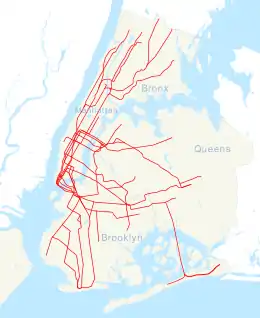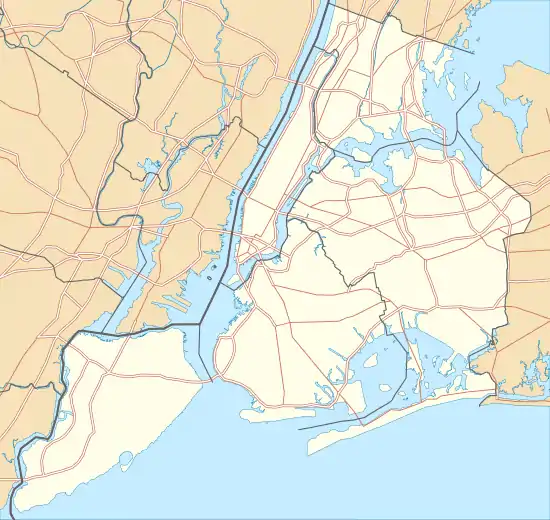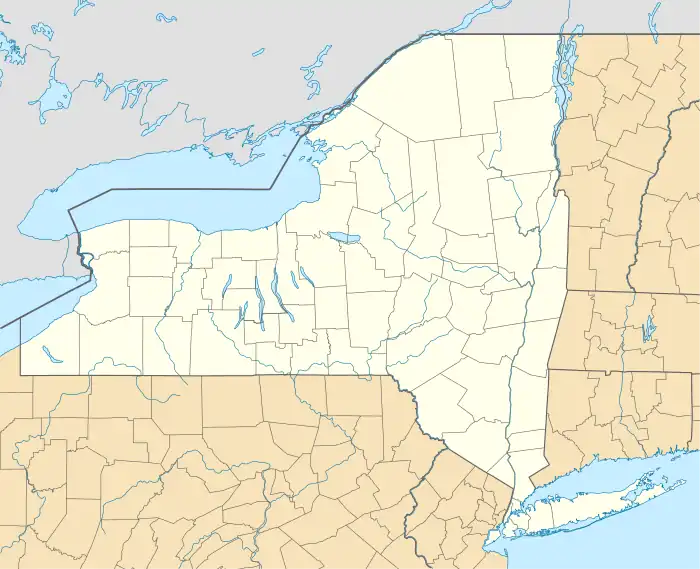Marble Hill–225 Street | ||||||||||||||||||||||||||||||||||||||||||||||||||||||||||||||||||||
|---|---|---|---|---|---|---|---|---|---|---|---|---|---|---|---|---|---|---|---|---|---|---|---|---|---|---|---|---|---|---|---|---|---|---|---|---|---|---|---|---|---|---|---|---|---|---|---|---|---|---|---|---|---|---|---|---|---|---|---|---|---|---|---|---|---|---|---|---|
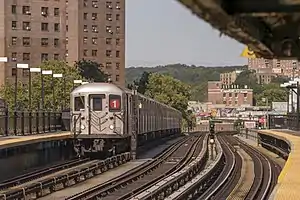 Downtown 1 train arriving | ||||||||||||||||||||||||||||||||||||||||||||||||||||||||||||||||||||
| Station statistics | ||||||||||||||||||||||||||||||||||||||||||||||||||||||||||||||||||||
| Address | West 225th Street & Broadway New York, NY 10463 | |||||||||||||||||||||||||||||||||||||||||||||||||||||||||||||||||||
| Borough | Manhattan | |||||||||||||||||||||||||||||||||||||||||||||||||||||||||||||||||||
| Locale | Marble Hill | |||||||||||||||||||||||||||||||||||||||||||||||||||||||||||||||||||
| Coordinates | 40°52′26″N 73°54′36″W / 40.874°N 73.91°W | |||||||||||||||||||||||||||||||||||||||||||||||||||||||||||||||||||
| Division | A (IRT)[1] | |||||||||||||||||||||||||||||||||||||||||||||||||||||||||||||||||||
| Line | IRT Broadway–Seventh Avenue Line | |||||||||||||||||||||||||||||||||||||||||||||||||||||||||||||||||||
| Services | 1 | |||||||||||||||||||||||||||||||||||||||||||||||||||||||||||||||||||
| Transit | ||||||||||||||||||||||||||||||||||||||||||||||||||||||||||||||||||||
| Structure | Elevated | |||||||||||||||||||||||||||||||||||||||||||||||||||||||||||||||||||
| Platforms | 2 side platforms | |||||||||||||||||||||||||||||||||||||||||||||||||||||||||||||||||||
| Tracks | 3 (2 in regular service) | |||||||||||||||||||||||||||||||||||||||||||||||||||||||||||||||||||
| Other information | ||||||||||||||||||||||||||||||||||||||||||||||||||||||||||||||||||||
| Opened | January 14, 1907 | |||||||||||||||||||||||||||||||||||||||||||||||||||||||||||||||||||
| Opposite- direction transfer | No | |||||||||||||||||||||||||||||||||||||||||||||||||||||||||||||||||||
| Traffic | ||||||||||||||||||||||||||||||||||||||||||||||||||||||||||||||||||||
| 2022 | 1,025,805[2] | |||||||||||||||||||||||||||||||||||||||||||||||||||||||||||||||||||
| Rank | 278 out of 423[2] | |||||||||||||||||||||||||||||||||||||||||||||||||||||||||||||||||||
| ||||||||||||||||||||||||||||||||||||||||||||||||||||||||||||||||||||
| ||||||||||||||||||||||||||||||||||||||||||||||||||||||||||||||||||||
| ||||||||||||||||||||||||||||||||||||||||||||||||||||||||||||||||||||
| ||||||||||||||||||||||||||||||||||||||||||||||||||||||||||||||||||||
| ||||||||||||||||||||||||||||||||||||||||||||||||||||||||||||||||||||
The Marble Hill–225th Street station (signed as 225th Street) is a local station on the IRT Broadway–Seventh Avenue Line of the New York City Subway. Located at the intersection of Broadway and 225th Street in Marble Hill, Manhattan, it is served by the 1 train at all times.
History

The West Side Branch of the original subway line was extended to 225th Street on January 14, 1907. It would briefly serve as the terminus for the line, until the structure of the 221st Street station was dismantled and moved to 230th Street, where a new temporary terminus was opened on January 27, 1907.[3]
To address overcrowding, in 1909, the New York Public Service Commission proposed lengthening the platforms at stations along the original IRT subway.[4]: 168 As part of a modification to the IRT's construction contracts made on January 18, 1910, the company was to lengthen station platforms to accommodate ten-car express and six-car local trains. In addition to $1.5 million (equivalent to $47.1 million in 2022) spent on platform lengthening, $500,000 (equivalent to $15.7 million in 2022) was spent on building additional entrances and exits. It was anticipated that these improvements would increase capacity by 25 percent.[5]: 15 The northbound platform at the 225th Street station was extended 95 feet (29 m) to the north.[5]: 114 The southbound platform was not lengthened.[5]: 106 Six-car local trains began operating in October 1910,[4]: 168 and ten-car express trains began running on the West Side Line on January 24, 1911.[4]: 168 [6] Subsequently, the station could accommodate six-car local trains, but ten-car trains could not open some of their doors.[7]
In Fiscal Year 1924, an additional stairway was constructed to the northbound platform to accommodate additional ridership from the New York Velodrome.[8]
The city government took over the IRT's operations on June 12, 1940.[9][10] Platforms at IRT Broadway–Seventh Avenue Line stations between 103rd Street and 238th Street, including those at 225th Street, were lengthened to 514 feet (157 m) between 1946 and 1948, allowing full ten-car express trains to stop at these stations.[7] A contract for the platform extensions at 225th Street and five other stations on the line was awarded to the Rao Electrical Equipment Company and the Kaplan Electric Company in June 1946.[11] The platform extensions at these stations were opened in stages. On July 9, 1948, the platform extensions at stations between 207th Street and 238th Street, including the 225th Street station, were opened for use at the cost of $423,000.[7][12] At the same time, the IRT routes were given numbered designations with the introduction of "R-type" rolling stock, which contained rollsigns with numbered designations for each service. [13] The route to 242nd Street became known as the 1.[14]
From August 21, 1989 to May 27, 2005 this was one of three (originally four) stations served by only the 9 train during rush hours (as well as middays before September 4, 1994), when skip stop service was operating. 1 trains served the station at all other times when the 9 was not operating. Skip-stop service as well as the 9 train were discontinued on May 29, 2005, at which point the 1 train began stopping at the station at all times.
Station layout
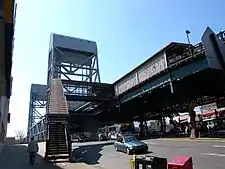
| Platform level | Side platform | |
| Northbound local | ← | |
| Peak-direction express | No regular service | |
| Southbound local | | |
| Side platform | ||
| Mezzanine | Fare control, station agent, MetroCard machines | |
| Ground | Street level | Entrances/exits |
This elevated station has three tracks and two side platforms. The center track is not used in revenue service.[15]The station is served by the 1 at all times[16] and is between 231st Street to the north and 215th Street to the south.[17] The southern half of the platforms has beige windscreens and red canopies with green frames and support columns while the northern half has black, steel, waist high fences and lampposts. The station signs are in the standard black name plates in white lettering.
The 1991 artwork here, by Wopo Holup, is called Elevated Nature I-IV. Portions are also located at four other stations on this line.
Marble Hill–225th Street is the northernmost subway station in Manhattan, and is one of two subway stations in Manhattan that are not located on Manhattan Island itself, the other one being Roosevelt Island on the F train.
Exits
All fare control areas are at platform level and there are no crossovers or crossunders. Both platforms have a station house, but only the southbound one is active. It has a turnstile bank, token booth, and one staircase going down to 225th Street and the northwest corner of Broadway. Access to and from the northbound platform is via two full-height turnstiles, one exit-only and the other entry-exit, and one staircase going down to the east side of Broadway across from the northwest corner of 225th Street.[18]
Location
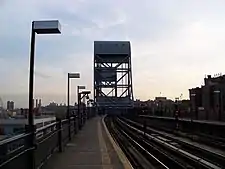
This station is less than 0.2 miles (0.32 km) from the Marble Hill station on Metro-North Railroad's Hudson Line. Just south of the station, the IRT Broadway–Seventh Avenue Line crosses the Broadway Bridge onto the island of Manhattan.
This station today and the neighborhood it serves reside on the north shore of the Harlem River Ship Canal, also known as Spuyten Duyvil Creek, and are thus geographically on the mainland. However, the neighborhood was formerly part of the island of Manhattan. The canal was constructed in 1895, separating the neighborhood from the rest of the island. After the original creek bed was filled in, Marble Hill became part of the mainland, although it is still considered part of Manhattan for administrative and political purposes.[note 1][19]
Notes
References
- ↑ "Glossary". Second Avenue Subway Supplemental Draft Environmental Impact Statement (SDEIS) (PDF). Vol. 1. Metropolitan Transportation Authority. March 4, 2003. pp. 1–2. Archived from the original (PDF) on February 26, 2021. Retrieved January 1, 2021.
- 1 2 "Annual Subway Ridership (2017–2022)". Metropolitan Transportation Authority. 2022. Retrieved November 8, 2023.
- ↑ "Farthest North In Town By The Interborough: Take a Trip to the New Station, 225th Street West" (PDF). New York Times. January 14, 1907. Retrieved August 16, 2015.
- 1 2 3 Hood, Clifton (1978). "The Impact of the IRT in New York City" (PDF). Historic American Engineering Record. pp. 146–207 (PDF pp. 147–208). Retrieved December 20, 2020.
 This article incorporates text from this source, which is in the public domain.
This article incorporates text from this source, which is in the public domain.{{cite web}}: CS1 maint: postscript (link) - 1 2 3 Report of the Public Service Commission for the First District of the State of New York For The Year Ending December 31, 1910. Public Service Commission. 1911.
- ↑ "Ten-car Trains in Subway to-day; New Service Begins on Lenox Av. Line and Will Be Extended to Broadway To-morrow". The New York Times. January 23, 1911. ISSN 0362-4331. Retrieved April 5, 2018.
- 1 2 3 Report for the three and one-half years ending June 30, 1949. New York City Board of Transportation. 1949. hdl:2027/mdp.39015023094926.
- ↑ 1923-1924 Annual Report of the Interborough Rapid Transit Company For The Year Ended June 30, 1924. Interborough Rapid Transit Company. 1924. p. 13.
- ↑ "City Transit Unity Is Now a Reality; Title to I.R.T. Lines Passes to Municipality, Ending 19-Year Campaign". The New York Times. June 13, 1940. ISSN 0362-4331. Archived from the original on January 7, 2022. Retrieved May 14, 2022.
- ↑ "Transit Unification Completed As City Takes Over I. R. T. Lines: Systems Come Under Single Control After Efforts Begun in 1921; Mayor Is Jubilant at City Hall Ceremony Recalling 1904 Celebration". New York Herald Tribune. June 13, 1940. p. 25. ProQuest 1248134780.
- ↑ "Platform Awards Made; Two Concerns to Enlarge Six Subway Stations of IRT" (PDF). The New York Times. June 14, 1946. p. 23. ISSN 0362-4331. Retrieved January 27, 2021.
- ↑ "More Long Platforms – Five Subway Stations on IRT to Accommodate 10-Car Trains" (PDF). The New York Times. July 10, 1948. p. 8. ISSN 0362-4331. Retrieved March 27, 2016.
- ↑ Brown, Nicole (May 17, 2019). "How did the MTA subway lines get their letter or number? NYCurious". amNewYork. Retrieved January 27, 2021.
- ↑ Friedlander, Alex; Lonto, Arthur; Raudenbush, Henry (April 1960). "A Summary of Services on the IRT Division, NYCTA" (PDF). New York Division Bulletin. Electric Railroaders' Association. 3 (1): 2.
- ↑ Dougherty, Peter (2006) [2002]. Tracks of the New York City Subway 2006 (3rd ed.). Dougherty. OCLC 49777633 – via Google Books.
- ↑ "1 Subway Timetable, Effective August 12, 2023". Metropolitan Transportation Authority. Retrieved August 26, 2023.
- ↑ "Subway Map" (PDF). Metropolitan Transportation Authority. September 2021. Retrieved September 17, 2021.
- ↑ "MTA Neighborhood Maps: Riverdale" (PDF). mta.info. Metropolitan Transportation Authority. 2015. Retrieved September 15, 2015.
- ↑ Tax Block & Tax Lot Base Map Files on CD-ROM Archived August 5, 2007, at the Wayback Machine, New York City Department of City Planning. Accessed July 26, 2007. "Marble Hill is a neighborhood that is part of the borough of Manhattan but is administratively often included with neighboring areas of the Bronx. Parts of Marble Hill are within Bronx Community District 7; the rest is within Bronx Community District 8."
External links
- nycsubway.org – IRT West Side: 225th Street
- Station Reporter – 1 Train
- The Subway Nut – Marble Hill–225th Street Pictures
- 225th Street (North) entrance from Google Maps Street View
- 225th Street (South) entrance from Google Maps Street View
- Platforms from Google Maps Street View
